 |
|
 |
2019
June
28
|
Mercer Lancaster Sherman, 1960-2019

Word has reached me that my Valwood schoolmate Mercer Sherman has died, on June 19,
of colon cancer, which he had been fighting for some time along with other health problems.
He was widowed, remarried, and separated, and is survived by a daughter to whom he was
very devoted and a wife from whom he was separated.
Mercer was a strong Christian and was known for supporting conservative political causes.
He had a degree in communication arts from Valdosta State University and was at one time
Program Syndicator/Director of Affiliate
Relations at CBN Radio Network.
I last saw him at the big dinner gathering we had during my
2015 trip.
He lived near my sister Julie, who now lives in Valdosta.
He will be missed.
Permanent link to this entry


|
2019
June
20
|
Drama around the Great Red Spot
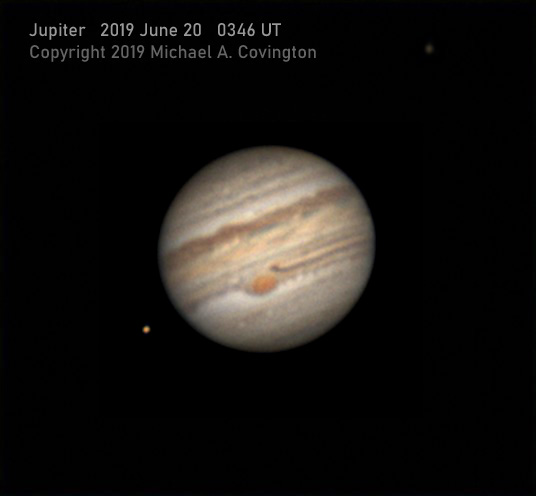
Last night we had unexpectedly clear weather around 11:30 p.m., and I got a
telescope out, photographed Jupiter, and got this rather remarkable image.
You see the Great Red Spot in its current, shrunken state, brighter red than I can
recall ever seeing it before, and also the effects of turbulence around it.
The Great Red Spot has been spinning off material.
That may be the cause of the dark streak that starts near it and continues to
the right.
What you see in this picture has been confirmed by other observers with
larger telescopes.
This picture was taken with a 5-inch telescope for two reasons.
I started the observing session suddenly
and didn't have much time for the telescope to equalize in temperature
to the surrounding air, and a smaller, less massive telescope would do this faster.
Also, Jupiter was low in the sky and I didn't
expect the air to be steady, so I thought a smaller aperture would have an advantage,
or at least less than the usual disadvantage compared to my 8-inch.
Stack of the best 75% of about 3000 video frames; Celestron 5 (vintage 1980),
3× extender, ASI120MC-S camera, processed with AutoStakkert, RegiStax, and Photoshop.
Permanent link to this entry


|
2019
June
19
|
Evangelical statement on artificial intelligence
I am one of the signers of a statement about the ethics of artificial intelligence
recently adopted by the Ethics and Religious Liberty Commission (ERLC) of the
Southern Baptist Convention.
You can read it here.
I wasn't involved in writing it; if I had been, it would have started with a definition of
artificial intelligence. But I agree with what it says. Most of the sections of it elaborate
the idea that we are responsible for what we do with our tools, even if the tools are
designed to imitate autonomous human behavior.
There is also an affirmation of the Christian view of marriage
and a rejection of the use of computers to create high-tech pornography.
The ERLC has many wise things to say about social issues, and you may enjoy
looking around their web site.
Notably, they do not endorse Trump.
Permanent link to this entry
EXCOEMCALLISTI = EX COEM. CALLISTI
A friend recently asked me to translate the inscription EXCOEMCALLISTI on a small
cross similar to this one.
Medieval Latin does not often stump me, but this one did.
Obviously, it's EX something CALLISTI, "from the something of Callistus,"
and I ventured that it might be a souvenir of the Catacombs of St. Callistus (Calixtus).
But what is COEM? Obviously an abbreviation; a word immediately following EX would have to
have a case ending other than EM.
An expert Latinist (Fr. John Zuhlsdorf) answered it for me. It's EX COEM[ETERIO] CALLISTI,
"from the cemetery (i.e., catacombs) of Callistus."
I didn't get coemeterio because it was a borrowed Greek word — one I should have
recognized because it's where we got cemetery.
And since the translation of EX COEM CALLISTI is nowhere on the Web, I'm recording it here.
Permanent link to this entry


|
2019
June
18
|
A structural change in American amateur astronomy
[Updated.]

I've written about how, after a long period of pulling apart, amateur and professional
astronomy are pulling together again. For the story, click here.
Today an
event has been announced that marks an important step in the pulling back together.
Sky and Telescope, the magazine that has held American amateur astronomers together since
the 1940s, has been acquired by the American Astronomical Society (AAS), which is the leading organization
of professional astronomers.
This may be a structural change in American amateur astronomy.
Instead of being a purely commercial magazine, Sky and Telescope now has a new mission to fulfill.
I expect it to continue doing what it does now, and also step into a new role of facilitating
communication between professionals and amateurs.
Amateur astronomy pulled away from professional astronomy in the 1970s and 1980s because of technology
— the professionals had CCDs, autoguiders, big telescopes, and big computers.
Many of the amateurs chose to simply enjoy looking at the sky and stop trying to contribute to science.
Soon after the pulling apart started, a rival magazine appeared, Astronomy, focusing on distinctly amateur
interests — celestial sightseeing, astrophotography,
and the new abundance of commercially available equipment.
It did an outstanding job of meeting amateurs where they were.
Sky and Telescope at the time was employee-owned, closely associated with Harvard University,
and addressed to both professionals and amateurs (for example, it reported on IAU meetings).
Competition, and, later, commercial ownership made Sky and Telescope become more
and more like Astronomy,
and that's where they still were a month or two ago — two increasingly similar magazines, with
the same purpose, leaving readers wondering whether they could really support two.
But the nature of amateur astronomy has changed.
Amateurs now have the same digital image sensors,
computer power, and Internet as the professionals, and the amateur and professional observers are
pulling back together. Sky and Telescope is undergoing the right change at the right time.
Plans are for it to change very little, but under AAS sponsorship I have great hopes that it will
move into a new niche and be more than just a hobby magazine.
Permanent link to this entry


|
2019
June
17
|
Just a bit of Mare Orientale
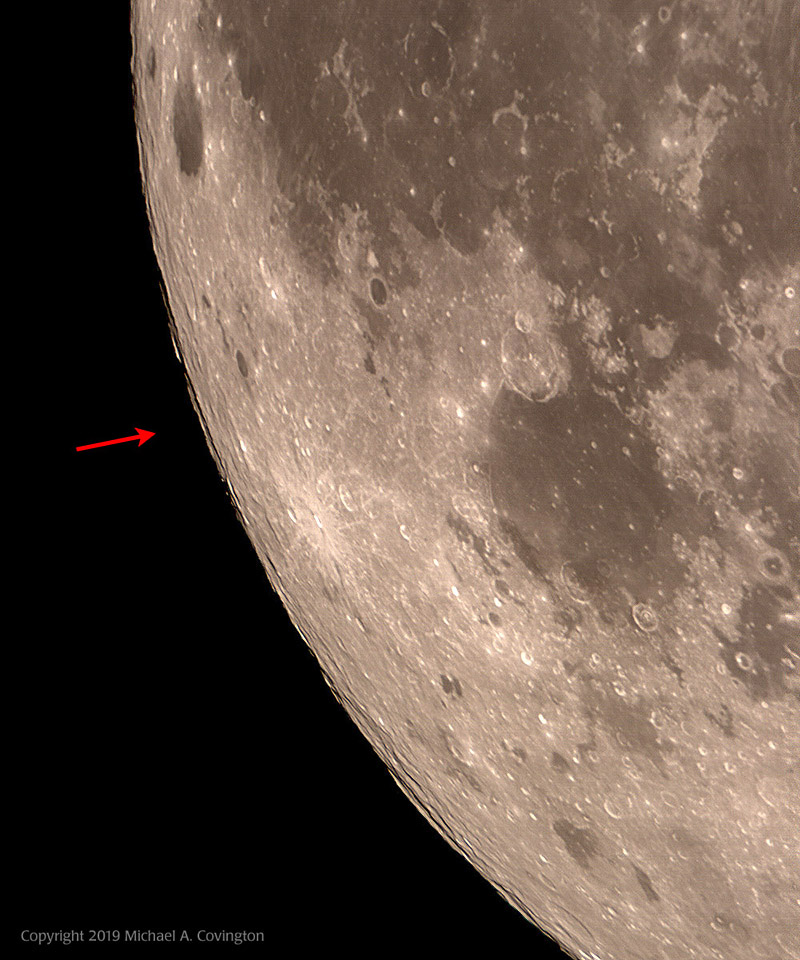
Attentive readers already know that I have made a minor hobby of
photographing the small part of
Mare Orientale that is sometimes visible from earth,
depending on the moon's position in its (off-center) orbit and thus the
angle from which we see it.
In this low-magnification picture, you don't see much of Mare Orientale, but the picture is a good
guide to where to look. Roughly, Mare Orientale is on the lunar west (celestial east)
edge of the moon's visible face, opposite Mare Crisium.
The big dark crater toward the top of the picture is Grimaldi.
The smaller dark one that is not too far inland from the arrow
(but to which the arrow does not point) is Crüger.
Compare to what you see in
the online edition
of Rükl's lunar atlas (captioned in Italian).
Stack of the best 75% of 3470 video frames, Celestron 5 telescope (vintage 1980)
at f/10, ASI120MC-S camera with clear UV-IR-block filter.
Permanent link to this entry
Smaller telescope, better Jupiter
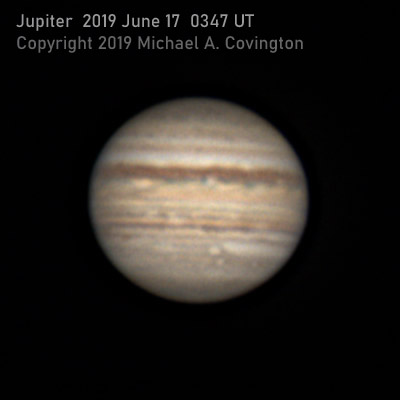
When the air is unsteady, sometimes a smaller telescope has an advantage.
Here's Jupiter last evening (June 16 here, June 17 in Greenwich Mean Time)
through my 1980 Celestron 5, with a 3× extender (giving f/30) and an ASI120MC-S
camera. Stack of the best 75% of 2610 video frames.
Permanent link to this entry


|
2019
June
15
|
The colorful moon
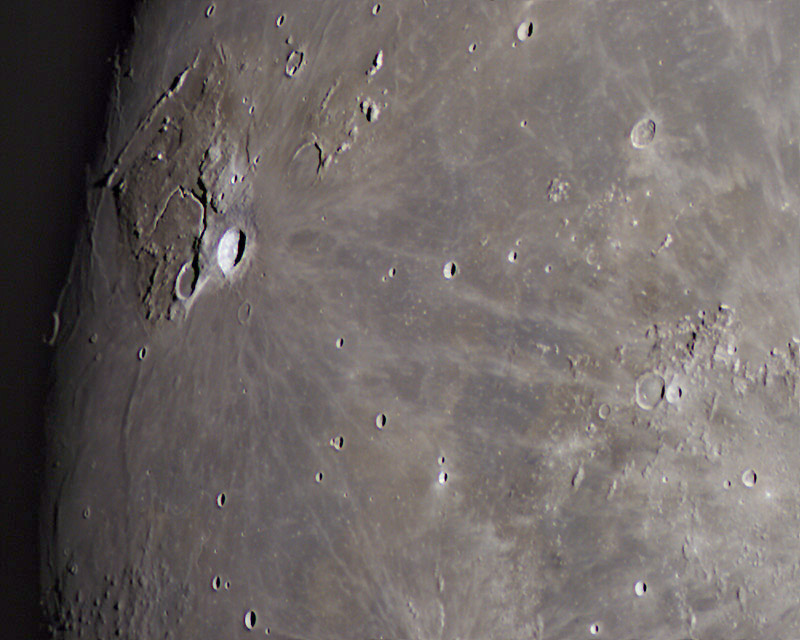
After two weeks of cloudy weather, I got my 8-inch telescope out in only slightly
cloudy weather last night and took a picture of the lunar crater Aristarchus and the
adjacent "seas" (maria, actually plains).
I've raised the color saturation in this picture so that you can see something that is
barely visible to the eye through a telescope once it's pointed out to you:
The moon is not colorless. The maria are browner in some places and bluer in others,
reflecting the presence of different kinds of rocks.
Stack of the best 75% of 3471 video frames, Celestron 8 EdgeHD at f/10, ASI120MC-S camera.
The moon was low in the sky, and the air was somewhat unsteady.
Permanent link to this entry
The not-so-great Red Spot
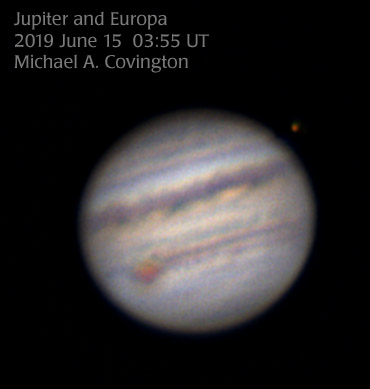
Here you see Jupiter and its satellite Europa. Europa's shadow is barely visible as a slight
notch on the edge of Jupiter.
This is not a good picture — Jupiter was low in the sky, and the air was unsteady —
but it's my first picture of Jupiter this season, and it shows something important:
the Great Red Spot has continued to shrink. A few days ago, in fact, it threw off some
red material, which other observers succeeded in photographing, and sat is a conspicuous "eye socket."
The "socket" is less prominent now, according to what I see in high-quality pictures by others,
but the Great Red Spot is less than half as wide as it was in the late 1800s, when astronomers started
making exact drawings
and measurements.
The Great Red Spot is an anticyclonic storm — a high-pressure area, a reverse hurricane —
that has been going on for over 300 years. Why so long? Two reasons: Jupiter is really big, so everything
should last longer, and Jupiter
does not have seasons. That is, its axis is not tilted substantially away from its orbit, so its weather doesn't
get interrupted, so to speak, by a seasonal cycle. There's no reason the Great Red Spot should last
forever. It may even have gone away once already (in the 1700s and
early 1800s) and come back again. Will I outlive it?
Permanent link to this entry


|
2019
June
8
|
Ashen Light of Venus explained
The latest issue of the Journal of the British Astronomical Association
contains an article by Richard McKim which, in the middle of reporting observations,
offers an explanation of the Ashen Light that I find convincing.
McKim, Richard (2019) The eastern and western elongations of Venus 2007-'17,
Part II: The nocturnal hemisphere, JBAA 129:149-157. Not yet available in
ADSABS
but will be soon.
As you recall, Venus shows phases like the moon because it is close to the sun, so we usually
see the sun lighting it from the side.
The Ashen Light is a glow sometimes seen in the unlit part of Venus.
It resembles the earthshine that we see on the moon, but it is much fainter and has long been unexplained;
there is nothing nearby to reflect light onto it.
Nobody sees the Ashen Light reliably. A few people have seen it occasionally. Many astronomers
have considered it to be an optical illusion, the mind filling in the missing part of the circle.
But there is now a much better explanation.
The Ashen Light is a well-known infrared phenomenon that occasionally reaches into the
visible part of the spectrum so that human eyes can see it.
The surface of Venus is very hot, about 900° F, hotter than Mercury
because of Venus's atmosphere. It is in fact at the threshold of being red-hot.
It glows strongly in the infrared and is regularly photographed using infrared light.
On one fateful night in 2009, amateur astronomer Daniele Gasparri photographed the Ashen Light
(through an infrared-blocking filter) and also photographed the unlit portion of Venus
glowing in the infrared (at a wavelength of 1000 nm).
It's obvious from the pictures that the two are the same phenomenon.
Even without the Gasparri observation, this explanation of the Ashen Light is highly credible.
Very simply, Venus seems to be glowing faintly because it is glowing, but right at the
limit of the human eye's spectral response.
That means the Ashen Light is visible, or not, depending on the observer's eyes,
the infrared transmission of the telescope, and conditions on Venus that might affect
the temperature or the translucency of the atmosphere.
That explanation had already been proposed by
astrophysicist Fredric W. Taylor in
The
Scientific Exploration of Venus (Cambridge, 2014).
The Gasparri observation and other research cited by McKim support it.
This reminds me of how another Venus mystery was solved.
A century ago, a major mystery for Venus observers was the existence
of dusky shadings on the bright sunlit portion.
Some observers saw them; some didn't. Debate raged.
By mid-century, it was established that the dusky shadings are real
(and prominent) in ultraviolet light and the only question was whether
they could be seen in visible light.
They should have been more visible to younger observers (with more UV-sensitive eyes)
using reflecting telescopes with inexpensive eyepieces (not much glass in the light path).
So young amateurs actually had the best view!
I never saw one, but one of my friends did, around 1970, and at the time we did
not realize that the mystery had been solved by ultraviolet photography.
Permanent link to this entry


|
2019
June
6
|
The Northern Crown
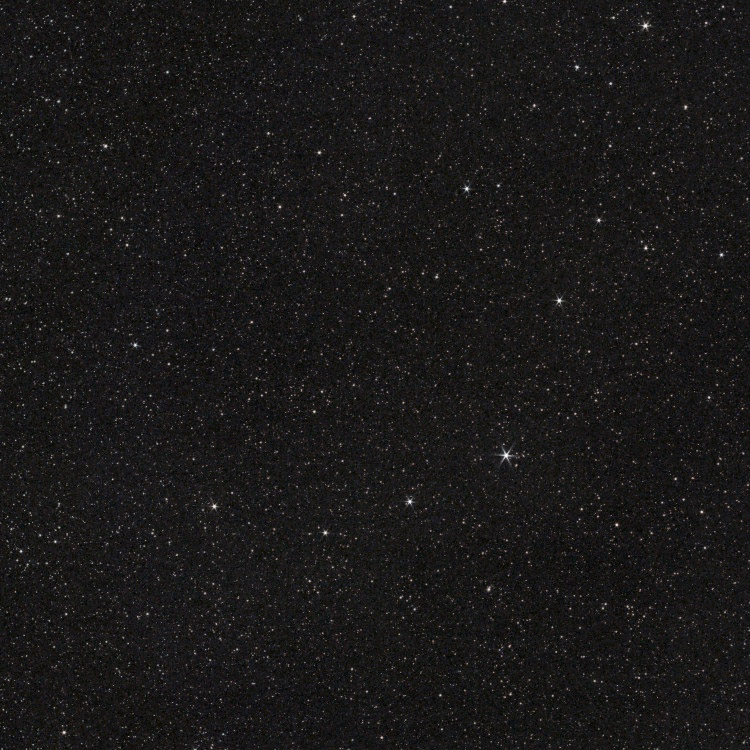
One thing I like about the
Aaron Memorial Lens
(vintage 1971 Nikkor-H 50/2) is that it makes the bright stars stand out in
pictures of the constellations.
That is presumably because of a small amount of residual spherical aberration.
Here you see Corona Borealis (the Northern Crown), a stack of nine 2-minute
exposures at f/4 with a Nikon D5500 at ISO 200 on an iOptron SkyTracker.
Permanent link to this entry
How long can you expose without guiding corrections?
My iOptron SkyTracker does not have any provision for autoguiding, so I need to know how
long it will track the stars well enough without corrections.
That of course depends on the focal length of the lens.
The picture of Corona Borealis above is part of a series of tests. What I do is photograph
a star field 10 times, then analyze the eccentricity (misshapenness) of the star images
using PixInsight.
With tiny star images and a digital camera, eccentricity never seems to go below an average
value of 0.6. That's because stars don't hit pixels squarely. On the average, a star is very likely
to be spread across two pixels in a random direction. As long as the direction is random, I don't mind.
So here are some histograms of eccentricity versus exposure time:
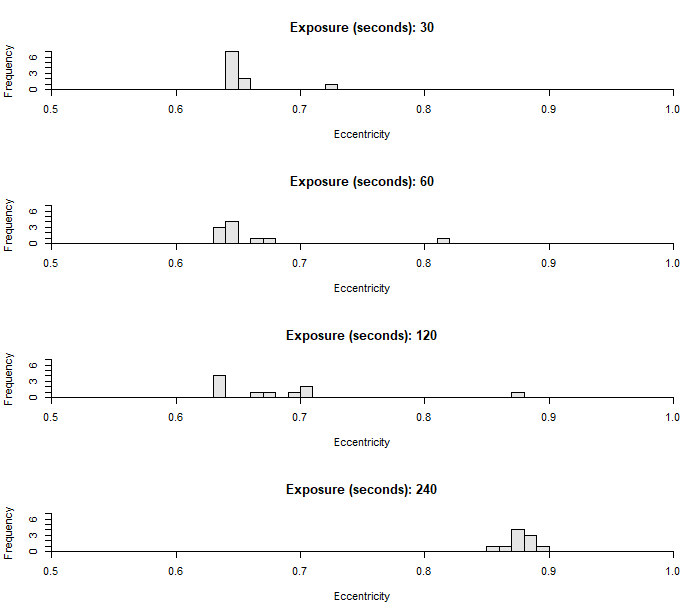
Here's what I think we learn from these:
- You don't win 'em all. One or two out of the ten frames were
poorly tracked even with short exposures.
That is due to random irregularities in the tracking.
-
There is a sharp threshold at which the exposure time is suddenly long
enough to span serious irregularities in the tracking.
As we go up from 30 to 60 and then 120 seconds, performance is only
slightly worse. But then, at 240 seconds, it's very bad.
-
The best exposure time with a 50-mm lens is 120 seconds or maybe a little less.
I will do the same test with a 105-mm lens soon.
Permanent link to this entry


|
2019
June
1
|
Intervalometers (exposure timers)
[Revised again.] [And again.]

Click on picture to see this product on Amazon
Above you see an intervalometer (exposure timer).
There seem to be two kinds on the market that look like this,
each sold under many brands, and both have the same LCD display.
The difference?
Type 1 is always on (always shows a display),
and times very accurately, not affected by temperature, although, curiously, the timing is
slow by a factor of 1 in 600 (that is, 1 second per 10 minutes), which I think is a software bug.
Type 2 has to be turned on (awakened) by pressing a button,
and times much less accurately, with noticeable variation due to
temperature (important to astronomers).
I have an old Type 1 (Phottix brand) for Canon and have just bought two Type 1 (Neewer brand)
for Nikon.
I also had a Type 2 (Neewer brand, 2016 or so) that recently failed. It had a thin, flexible
cable with interchangeable connectors for several kinds of cameras.
Its cable broke in 3 places and stopped me from doing astrophotography with my Nikons.
That's why I decided to get 2 spares.
Another possible variation is whether the "interval" is the time between the exposures
or the time from the start of one to the start of the next.
All three that I have now are the latter, but my notes show that the one that failed
may have worked the other way.

The electrical requirements for Canon and Nikon shutter control seem to be the same
(more about that here
and here).
Canon uses standard 2.5-mm phone plugs on most of the newer cameras.
Nikon uses a proprietary "DC-2" connector (shown above), which is not available as a standard
electronic part.
However, it is easy to get cables that have
a DC-2 connector on one end and a phone plug (either 2.5mm or 3.5mm) on the other end
(this,
for instance).
These are used for all sorts of camera remote controls. The phone plug has the same meaning as
on Canons: connect ring to sleeve to autofocus; connect tip and ring to sleeve to take the picture;
and on most cameras,
do not connect tip to ring except when they are both being connected to sleeve.
Permanent link to this entry
Cough, cough...
Melody and I are both down with bronchitis, a very time-consuming ailment. The level of activity
here will pick up as conditions permit.
Permanent link to this entry


|
|
|
This is a private web page,
not hosted or sponsored by the University of Georgia.
Copyright 2019 Michael A. Covington.
Caching by search engines is permitted.
To go to the latest entry every day, bookmark
http://www.covingtoninnovations.com/michael/blog/Default.asp
and if you get the previous month, tell your browser to refresh.
Portrait at top of page by Sharon Covington.
This web site has never collected personal information
and is not affected by GDPR.
Some older pages that contain Google Ads may use cookies to manage the rotation of ads.
No personal information is collected or stored by Covington Innovations, and never has been.
This web site is based and served entirely in the United States.
In compliance with U.S. FTC guidelines,
I am glad to point out that unless explicitly
indicated, I do not receive substantial payments, free merchandise, or other remuneration
for reviewing or mentioning products on this web site.
Any remuneration valued at more than about $10 will always be mentioned here,
and in any case my writing about products and dealers is always truthful.
Reviewed
products are usually things I purchased for my own use, or occasionally items
lent to me briefly by manufacturers and described as such.
I am an Amazon Associate, and almost all of my links to Amazon.com pay me a commission
if you make a purchase. This of course does not determine which items I recommend, since
I can get a commission on anything they sell.
|
|














